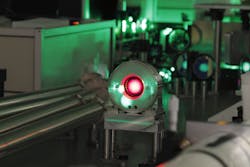ULTRAHIGH-INTENSITY LASERS: OSU’s SCARLET laser aims for 500 TW/15 J/30 fs pulses
“When the SCARLET laser comes online in June 13, 2012 [with experiments beginning in August], it will be one of the most powerful lasers in the world and the highest-peak-power sub-one-hundred-femtosecond laser in the United States,” says Enam Chowdhury, senior research associate and leader of the Petawatt Development team in the Science Center for Advanced Research on Lasers and Engineered Targets (SCARLET) laser facility in the High Energy Density Physics (HEDP) group at Ohio State University (Columbus, OH). Chowdhury says that the 815 nm center-wavelength SCARLET laser was engineered to reach a 500 TW peak power and 1021 W/cm2 intensity levels with 30 fs pulsewidth, 15 J pulses in a 5 μm full-width-half-maximum spot size with a one-shot-per-minute repetition rate. In 2013, installation of a deformable mirror will be completed in the laser chain to push SCARLET’s peak intensity beyond 1022 W/cm2.
While the specifications are impressive, the repetition rate is particularly noteworthy. “The usability of current ultra-intense laser systems is limited, owing to their low repetition rate. Typically, large-scale laser systems are only able to hit several shots per day at most,” says Chowdhury.
“One of the primary goals of SCARLET is to reliably run experiments consisting of hundreds of shots per day, allowing our HEDP group to more accurately model high-energy-density systems and to truly understand just what happens in ultra-intense light/matter interactions,” adds professor Richard Freeman, the HEDP Laboratory group leader.
SCARLET laser parameters
Although its maximum peak power aims at 500 TW, SCARLET will be known as a 0.5 PW or petawatt-class laser that will operate in two modes, including a short-pulse kilohertz mode (0.1–0.8 mJ, 25 fs pulses at 1 kHz) with a wavelength range of 0.8–4.0 μm for laser damage studies.
Maximum power is achieved in SCARLET by sending the kilohertz-level laser output through an additional mirror-stripe grating stretcher (pulses stretched to 800 ps) in a dual-chirped-pulse-amplification (DCPA) architecture followed by various pulse-cleaning apparatuses, including a cross-polarized wave (XPW) generator system. The pulse also travels through a number of Ti:sapphire multipass amplifiers with the final amplifier being pumped with two 25 J/pulse neodymium pump lasers at 527 nm and a new compressor that uses a pair of 36-cm and 56-cm-long diffraction gratings. The entire laser system is housed in a Class 1000 cleanroom complete with entrance air shower and networked temperature and humidity sensors.
The SCARLET laser output is then directed under vacuum into a 1200 ft2 target room and compressed inside a 10.5-ft-long, 6-ft-diameter cylindrical vacuum chamber before being sent to the final f/2 focusing off-axis parabola inside a 35-port chamber with a 3-ft, 7-in. diameter and a 3-ft, 6-in. height.
In addition to its eight laser diagnostic devices, including on-shot focal spot and spatial chirp diagnostics, SCARLET also includes x-ray diode, pre-plasma shadowgraphy, Schlieren imaging, gamma-ray and neutron spectrometer, Thompson parabola, interferometer, HOPG x-ray spectrometer, x-ray pinhole imaging camera, and K-alpha bent-crystal imaging spectrometer diagnostic instrumentation, all assisted by a six-node computer cluster with 48 cores and 130 Gbytes of RAM per node and a 10 Tbyte RAID (redundant array of independent disks) storage array.
Planned experiments
The interaction of ultrahigh-intensity, ultrashort-pulsed laser light with solid targets is the primary area of study for SCARLET researchers. “While the sun illuminates our world with an approximate 0.1 W/cm2 at the surface of the earth, SCARLET’s 22 to 23 order-of-magnitude intensity increase allows study of light/matter interactions under star-like conditions in a laboratory setting,” says Kramer Akli, senior research scientist who heads the experimental campaigns at SCARLET.
One anticipated area of study is fast-ignition fusion. Unlike the National Ignition Facility (NIF) program that requires 192 laser beams with 5 kJ each in a few-nanosecond pulse impinging on a few-millimeter-sized target, fast-ignition fusion involves a 50 kJ, 20 ps pulse interacting with a target manufactured with relatively modest precision for a less-expensive, easier-to-maintain fusion energy source. The SCARLET laser can assist with understanding how laser pulses can best ignite laser fusion targets by analyzing particle and energy transport through hot dense matter.
And in addition to experiments in laser-driven x-ray technology and its use as a potential neutron/gamma-ray source, SCARLET will also be used to generate energetic protons for studies in proton fast ignition, proton radiography for material diagnostics, and for proton therapy—a form of radiation therapy to combat cancer.
About the Author

Gail Overton
Senior Editor (2004-2020)
Gail has more than 30 years of engineering, marketing, product management, and editorial experience in the photonics and optical communications industry. Before joining the staff at Laser Focus World in 2004, she held many product management and product marketing roles in the fiber-optics industry, most notably at Hughes (El Segundo, CA), GTE Labs (Waltham, MA), Corning (Corning, NY), Photon Kinetics (Beaverton, OR), and Newport Corporation (Irvine, CA). During her marketing career, Gail published articles in WDM Solutions and Sensors magazine and traveled internationally to conduct product and sales training. Gail received her BS degree in physics, with an emphasis in optics, from San Diego State University in San Diego, CA in May 1986.
